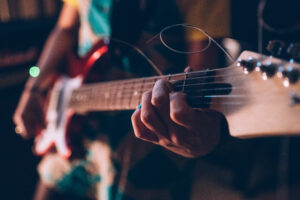advanced
How to Play “Sleepwalk” on the 3-String Guitar! Guitar TABs Included!
“Sleepwalk” by Santo and Johnny is one of the most recognizable instrumental melodies in Rock & Roll history. It’s one of those songs that, within the first few notes, recalls the absolute essence of an era. The distinctive melody was originally written and recorded for lap steel guitar, with rhythm section laying down a tasteful harmonic and rhythmic bed. This 3-String arrangement of the song is a chord/melody arrangement, meaning the melody is played on the higher strings, and the harmony (chord changes & bassline) are played on the lower strings. Essentially, you are playing the entire band’s music on 3 strings.
I’ve written out the tablature below to correspond to the video above. It’s in Open G tuning (G-D-G) using the A, D, & G string from a standard 6-string pack.
Thanks for keeping the Roots alive, and don’t forget to click “FOLLOW” on the right-hand side of this page to stay up-to-date with new lessons and articles!

advanced
Fun and Effective Guitar Exercises: Elevate Your Playing with These 5 Simple Techniques
Think you need natural talent to become a great guitarist?
Think again! This article will show you the secret to becoming a great guitarist. We’re diving into the world of guitar exercises – the secret sauce to becoming a guitar wizard. Whether you’re new to the guitar world or a seasoned pro, these exercises will help you improve your playing and have a blast while doing it.
So grab your guitar, tune those strings, and let’s embark on a musical journey with these awesome guitar exercises!
Why Guitar Exercises Are Your Superpower
Before we jump into the guitar exercises, let’s talk about why they’re so important. Just like athletes warm up and practice drills to become better, guitarists use exercises to build strength, coordination, and technique. These exercises are like little challenges that train your fingers and brain to work together smoothly.
Guitar Exercise 1: Spider Crawls for Finger Dexterity
Imagine your fingers are little spiders exploring the fretboard. This exercise helps you improve your finger dexterity and stretch. Here’s how to do it:
1. Place Your Fingers: Start on the first fret with your index finger on the first string (thinnest), middle finger on the second string, ring finger on the third string, and pinky on the fourth string.
2. Crawl Up: Play each fret in order, moving up one fret at a time, with the same finger pattern. When you reach the fourth fret, move your fingers up to the next string and start again.
3. Crawl Down: Once you reach the fourth string, reverse the process. Play each fret, moving down one fret at a time.
This exercise might feel a bit tricky at first, but with practice, your fingers will become more agile and flexible.
Guitar Exercise 2: Strumming Patterns for Rhythm
Rhythm is like the heartbeat of music, and strumming patterns are the way to make your guitar sing with a groovy rhythm. Here’s a simple strumming exercise to get you started:
1. Choose a Chord: Pick a chord you’re comfortable with, like G, C, or D.
2. Down-Up Strumming: Using a relaxed wrist, strum down with your thumb or pick across the strings. Then, strum up in the same way. Start slow, and gradually speed up as you get comfortable.
3. Mix It Up: Experiment with different strumming patterns. Try two downs followed by two ups, or switch between quick downs and slow ups. This exercise will help you develop a solid sense of rhythm.
Guitar Exercise 3: Chromatic Scale for Finger Independence
The chromatic scale is like a musical ladder with every fret as a rung. This exercise is great for finger independence and coordination:
1. Start on the First Fret: Place your index finger on the first fret of the low E string.
2. Finger Pattern: Use your index, middle, ring, and pinky fingers for each fret. So, index on the first fret, middle on the second, ring on the third, and pinky on the fourth.
3. Move Up a String: Once you reach the fourth fret on the low E string, move to the A string and start the pattern again.
4. Challenge Yourself: Try playing the chromatic scale up and down the fretboard, moving across all six strings. This exercise will boost your finger independence and accuracy.
Guitar Exercise 4: Basic Chord Progressions for Transitions
Smooth chord transitions are key to sounding polished while playing. Let’s work on transitioning between two simple chords:
1. Choose Two Chords: Pick two chords, like G and D. Start by practicing the individual chords until you’re comfortable with them.
2. Strum and Switch: Strum the first chord a few times, then switch to the second chord. Keep alternating between the two chords, gradually increasing your speed.
3. Challenge Yourself: Experiment with different chord progressions. You can try G to C, D to A, or any combination you like. As you practice, your transitions will become smoother.
Guitar Exercise 5: Ear Training with Melodies
Developing your ear is crucial for playing by ear and improvisation. This exercise helps you recognize melodies by ear:
1. Simple Melody: Choose a short and simple melody from a favorite song.
2. Find the Notes: Try to figure out the melody on your guitar by ear. Start with one note at a time and build it up.
3. Play Along: Listen to the original melody and play along. This exercise sharpens your listening skills and helps you replicate melodies.
Guitar exercises are a crucial part of improving your guitar-playing skills. Remember, the more you practice these exercises,  the stronger your fingers will become, and the smoother your playing will sound.
the stronger your fingers will become, and the smoother your playing will sound.
Take your playing to the next level by using the resources I provided. You can explore a variety of exercises that will challenge you to build a deeper connection with your guitar and advance you through your musical journey. So grab your guitar, start practicing, and let’s make some music!
-
beginner11 months ago
Exploring Different Guitar Types: A Beginner’s Guide
-
advanced11 months ago
Fun and Effective Guitar Exercises: Elevate Your Playing with These 5 Simple Techniques
-
beginner9 years ago
3-String or 4-String? How to Decide Which is Right for You!
-
Blues Guitar8 years ago
Go-To Tunings for Blues Slide Guitar
-
Uncategorized11 months ago
Acoustic Guitar Sizes: Finding Your Perfect Fit
-
Blues Guitar7 years ago
Jack Daniel’s Whiskey Barrel Guitar: How It’s Made and What it Sounds Like
-
Guitars11 months ago
Bass vs Guitar: Exploring the Musical Journey
-
Uncategorized11 months ago
The Guitar Clamp: Shedding Light on Its Name and Purpose
